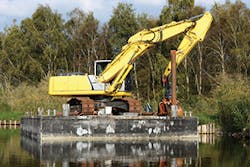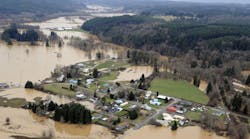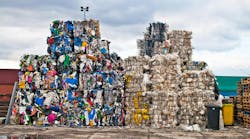Editor’s note: This article first appeared in the March/April 2016 edition of Stormwater.
Throughout the 1800s, skies over European cities were dark with the smoke of burning coal. In Britain alone, dense populations, a shortage of wood, and new commerce derived from steam power “fueled” coal’s use from 50 million tons in 1850 to 250 million tons by 1900. For rich and poor, the sulfurous, large black chunks of soft coal were a staple commodity and primary source of heat, energy, and industry.
Along the way, methods improved for carbonizing coal—heating it at high temperatures in furnaces—to make coke. This refinement became the key to meeting increased demands for iron and steel production, and it provided a source of fuel for locomotives. With coal-gas-powered lighting and longer workdays, the Industrial Revolution flourished, and with the dubious benefits of longer workdays, life sped on toward a new century. Galvanized by coal, business was booming, new technologies arose, and metered gaslights lit parlors, brought theatres to life after dark, and brought safety to street corners.
Amidst these innovations, a byproduct called coal tar was created. This sticky, viscous stuff (resembling the creosote made from wood used on railway ties) turned out to be ideal for mixing with stones to create a sealed, waterproof surface called tarmac (tar over macadam). Scientists found that coal tar had medicinal properties, too, and discovered a chemical cornucopia of agents that could be derived from the product.
A Miracle in the Making
But one product, first synthesized by German scientists, came to be hailed as a miracle discovery. It was nonflammable, had tremendous insulating capacity, and could be used as a coating, an extender for paints, a flame retardant, and much more. It was inert, nonreactive, and nonconductive with a high flashpoint. This miracle product derived from coal tar was called polychlorinated biphenyl (PCB), and for decades its stable chemical properties were exploited for everything from carbonless paper to waterproofing. One of its biggest draws came during the electrification boom. Its stability and inert property made it perfect to insulate transformers and capacitors.
PCB sold in huge quantities around the world. Scientists continued to experiment and found the properties of the substance could be enhanced. With added carbon atoms and chlorine mass, PCB became a nearly waxy substance, ideal as an extender for pesticides to increase their adhesion when sprayed. And it lasts—resistant to processes of natural degradation—for a long time, cycling through air, water, and soil for decades.
Today, however, with the benefit of history, biomedical science, and technology on our side, all of this sounds like a recipe for environmental disaster. Which in effect it was. PCBs were the proverbial double-edged sword. They could reduce the risk of death from fire when added as a flame retardant to clothing and upholstery, keep capacitors and transformers cool, and stabilize paints, hydraulic fluids, and floor finishes. Yet it was these very desirable attributes that made them the lingering environmental health threat that today, more than four decades after they were banned from use, continue to plague us in with their resistance. And the US was the largest producer of PCBs.
“We didn’t always hate them,” says Kevin Sowers, Ph.D., associate director and professor at the Institute of Marine and Environmental Technology (IMET) at the University of Maryland in Baltimore. “They were called the ‘miracle chemical’ because of their stability and were perfect for cooling. PCBs used for cooling in high-temperature situations would not boil off, and because they had dielectric properties they could insulate but not conduct. They were safe to use and would not short out electrical elements, such as transformers and capacitors.
“But because they are this miracle,” he explains, “they aren’t going anywhere, and the manufactured product was so stable in its enhanced forms they are not going to break down from exposure to natural environmental processes. They need to have special enzymes to break down, but you need a way to get the enzymes to these chemicals.”
As an anaerobic microbiologist, Sowers has been involved in researching methods that would be the perfect “organic recipe” to render PCBs harmless, because as he explains, “this is a global problem and they are found everywhere, including such unlikely places as the Arctic.”
Early Warning Wake-Up Calls Largely Ignored
For decades, scientists and health professionals knew that the chemical exerted dangerous properties. More than 100 years ago, exposure to chlorine during manufacturing caused disfiguring acne on workers, and the condition was dubbed chloracne, yet it would be another half century until the link to aromatic hydrocarbons was identified.
As the beneficial uses of PCBs multiplied, manufacturing escalated, and users and manufacturers of PCBs often put the effluent from those processes into the sewer systems, most of which were directly linked to public waterways. By the 1930s, public health experts were finding links between liver damage in plant workers and exposure to chlorinated hydrocarbons. For the next several decades, wrangling among health advocates, government, and corporate decision makers over the use of PCBs dragged on. Medical experts, scientists, and corporations had more than enough evidence that these agents were harmful, but workers, waterways, and food sources continued to be exposed. Finally, in 1979, EPA banned PCBs, but much damage had already been done.
However, it was the public outcry over PCB contamination arising from the grassroots efforts of residents along New York’s Hudson River that became the catalyst for real action. According to the New York Riverkeeper, a not-for-profit organization that advocates for water-quality issues, “Between 1947 and 1977 two General Electric (GE) capacitor manufacturing plants discharged an estimated 1.3 million pounds of PCBs into the Hudson River.” These contaminants are now “found in sediment, water and wildlife throughout the Hudson River ecosystem as far south as the New York Harbor” and “also found in people,” says Riverkeeper.


